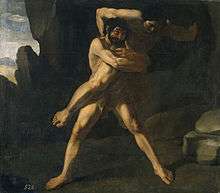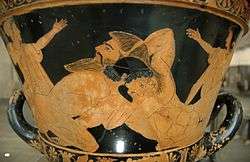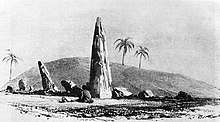Antaeus
Antaeus (/ænˈtiːəs/, Greek: Ἀνταῖος, Antaîos, lit. "Opponent", derived from ἀντάω, antao – I face, I oppose), known to the Berbers as Anti, was a figure in Berber and Greek mythology.[1] In Greek sources, he was the giant son of Poseidon and Gaia, who lived in the interior desert of Libya.[2][3] His wife was the goddess Tinge, for whom the city of Tangier in Morocco was named, and he had a daughter named Alceis or Barce. He was famed for his loss to Heracles as part of his twelve Labours.
 Hercules Fighting Antaeus (1634), by Francisco de Zurbarán | |
| Grouping | Legendary creature |
|---|---|
| Region | Africa |
Mythology


Antaeus would challenge all passers-by to wrestling matches and remained invincible as long as he remained in contact with his mother, the earth.[4] As Greek wrestling, like its modern equivalent, typically attempted to force opponents to the ground, he always won, killing his opponents.[4] He built a temple to his father using their skulls.[4] Antaeus fought Heracles as he was on his way to the Garden of Hesperides as his 11th Labour. Heracles realized that he could not beat Antaeus by throwing or pinning him. Instead, he held him aloft and then crushed him to death in a bear hug.[5][6]
The contest between Heracles and Antaeus was a favored subject in ancient[4] and Renaissance sculpture.[7]
Location in Africa
Antaeus is placed in the interior desert of Libya.[8] He was probably incorporated into Greek mythology after the Greek conquest of Libya in the mid-seventh century.[1]

A location for Antaeus somewhere far within the Berber world might be quite flexible in longitude: when the Roman commander Quintus Sertorius crossed from Hispania to North Africa, he was told by the residents of Tingis (Tangier), far to the west of Libya, that the gigantic remains of Antaeus would be found within a certain tumulus; digging it open, his men found giant bones; closing the site, Sertorius made propitiatory offerings and "helped to magnify the tomb's reputation".[9] It is proposed that this monument is the Msoura stone circle, 50 km from Tangier.[10] In Book IV of Marcus Annaeus Lucanus' epic poem Pharsalia (c. AD 65-61), the story of Heracles' victory over Antaeus is told to the Roman Curio by an unnamed Libyan citizen. The learned client king Juba II of Numidia (died 23 BC), husband of the daughter of Antony and Cleopatra, claimed his descent from a liaison of Heracles with Tinga, the consort of Antaeus.[11] In his Life of Sertorius cited above, Plutarch recounts what he says to be a local myth, according to which Heracles consorted with Tinge after the death of Antaeus and had by her a son Sophax, who named a city in North Africa Tingis after his mother. Sophax in his turn was father of Diodorus who conquered many Libyan peoples with his army of Olbians and Mycenaeans brought to Libya by Heracles.[12] Moreover, some related that Heracles had a son Palaemon by Iphinoe, the daughter of Antaeus and (presumably) Tinge.[13]
Scholiasts on Pindar's Pythian Ode 9 also recorded a story which made Antaeus king of the city Irassa in Libya, and father of a daughter named either Alceis or Barce. Antaeus promised her hand to the winner of a race, just like Danaus did to find new husbands for his daughters. Alexidamus beat all the other suitors in the race and married the daughter of Antaeus. Three versions of this story, with minor variations, were collected by the scholiasts; one of those versions made Antaeus, king of Irassa, a figure distinct from the Antaeus killed by Heracles, while another one suggested that they were one and the same.[14]
The ancient city of Barca, probably located at Marj, Libya, was also called Antapolis after Antaeus.[15] Antaeopolis is also the Graeco-Roman name of Tjebu, an Egyptian city. They identified the tutelary god of Tjebu, Nemty, a fusion of Seth and Horus, with Antaeus, although he may be different from the Libyan Antaeus.
Notes
- Freely, John (30 March 2014). A Travel Guide to Homer: On the Trail of Odysseus Through Turkey and the Mediterranean, by John Freely, page 151. ISBN 9781780761978. Retrieved 11 December 2019.
- Apollodorus, 2.5.11
- Hyginus, Fabulae 31.
- EB (1878).
- Pseudo-Apollodorus, Bibliotheke ii. 5.
- Hyginus, Fabula 31.
- Kleiner, Fred S. (1 February 2008). Gardner's Art Through the Ages: V. 2: A Global History. Cengage Learning EMEA. p. 550. ISBN 978-0495410607.
- I. Malkin, Myth and Territory in the Spartan Mediterranean, 1994:181-87, giving sources, noted in Robin Lane Fox, Travelling Heroes in the Epic Age of Homer, 2008:182 and note 51.
- Fox 2008:182, noting Plutarch, Sertorius9.3–4.Fox 2008:182
- Tertre de M'zora Archived 2004-06-24 at the Wayback Machine (in French)
- Pliny, Natural History, 5. 2–3; Strabo 17. 3. 8 noted in D.W. Roller, The World of Juba II and Kleopatra Selene, 2003:54 and 154, and by Fox 2008:182.
- Plutarch, Life of Sertorius, 9. 4
- Tzetzes on Lycophron 662
- Scholia on Pindar, Pythian Ode 9, 185, referring to Pherecydes, Pisander of Camirus and other unspecified writers
- Matthew S. Gordon; Chase F. Robinson; Everett K. Rowson; Michael Fishbein, eds. (2017). The Works of Ibn Wāḍiḥ al-Yaʿqūbī (Volume 1): An English Translation. Brill. p. 182. ISBN 9789004364141.
References

Further reading
- . Encyclopædia Britannica. 2 (11th ed.). 1911. p. 88.


- Apollodorus, Apollodorus, The Library, with an English Translation by Sir James George Frazer, F.B.A., F.R.S. in 2 Volumes. Cambridge, Massachusetts, Harvard University Press; London, William Heinemann Ltd. 1921.
- Hyginus, Gaius Julius, The Myths of Hyginus. Edited and translated by Mary A. Grant, Lawrence: University of Kansas Press, 1960.